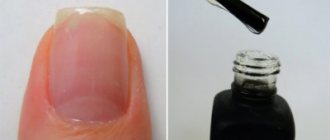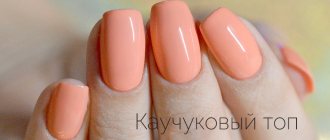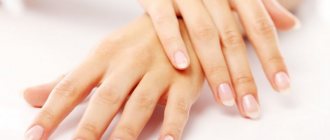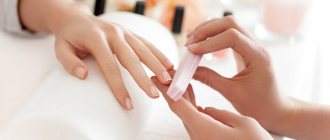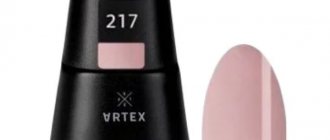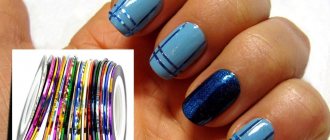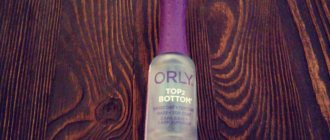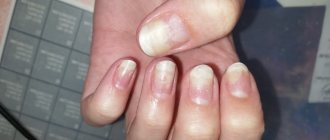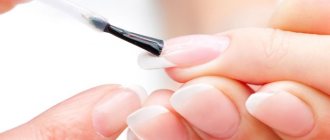Manicure is always loved and appreciated by the fair sex. Today it is considered fashionable to make it a nail gel, the advantage of which compared to simple varnish is that there is no need for constant tinting and processing of nails after application.
Covering nails with gel polish turns out to be very thin, which is why it looks much more natural and does not harm the nail plate, strengthening it. But in order for a manicure with gel polish to turn out good, it’s worth getting acquainted with the intricacies of its creation.
Why does gel polish flake off?
Nowadays there are a huge number of manicure and gel polish techniques. In most cases, the master suggests strengthening and leveling with a base. This is suitable if the nails are by nature quite strong, durable, hard and hold the material well. However, this is not always the case.
Why does gel polish flake off:
- In some cases, the plate is soft, thin and very similar to paper or napkin. It is difficult to strengthen such nails with a base. Despite the fact that the Nail industry now offers a huge amount of materials for both thin and durable plates, even a very hard and hard base cannot cope with thin and flaky nails.
- The fact is that if thin, bendable nails are covered with a soft and plastic base, then the coating will move along with the nail plate. In turn, because of this, the natural plate will peel off from the artificial material from underneath.
- Thus, you should not expect the coating to last for three weeks. Usually gel polish comes off like a film on such nails in just a week. If a rigid base is used, then as a result of the mobility of the natural plate, chips will appear on the coating over time. It will come off the plate, but in pieces, not in whole layers.
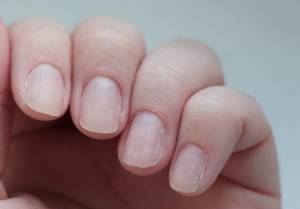
Peeling nails
Why is shellac so popular?
If we talk about Voronezh, shellac is mainly used by beauty salons and nail bars. It is convenient for salons to use this material. Covering time is 30 – 40 minutes. One master in the salon can serve 8–10 clients per day. In nai bars the client norm is even higher, 20 – 30 clients per day.
If you remember that shellac is usually worn for 7-10 days, then it turns out to be a very profitable conveyor belt for salons and nail bars. Today the salon let the client go, and a week later he goes back to the salon to renew his coating. It is not profitable for salons for their specialists to spend 2-2.5 hours working with each client, and for the coating to last at least two weeks. If you do this, the flow of customers will decrease significantly. One master can serve, at best, three clients a day. Clients will go for correction once every two or three weeks.
Salons work on those products that are primarily beneficial to them. They will not tell you that shellac is not suitable for you because you have thin, weakened nails. You will be given a coating, and since you have thin nails, you will be offered additional care products. Naturally for additional money.
Why do nails peel under gel polish?
Don't blame the technician for not being able to take the coating off for even a week. The properties of your own natural plate are of great importance. If it is very soft and mobile, then no base will stick to such nails. There are other reasons why nails peel under gel polish. Below we will look at the most popular of them.
Why do nails peel under gel polish:
- Improper preparation of the nail plate. The fact is that most craftsmen make one main mistake - they do not remove the natural gloss from the surface, but try to file off the plate as much as possible, moving the file in different directions. In fact, it is best to move the file in one direction.
- Insufficient defatting. Many masters believe that it is not worth using an acid primer when coating with regular base and gel polish. In fact, it all depends on the nail plate. If before this a cream was applied, or some work was performed involving fatty, oily substances, then it makes sense to thoroughly degrease the nail plate with alcohol, and apply a dehydrator and primer several times. In turn, this will help to completely remove fat and all debris from the nail plate, which can cause detachments.
- Very wet hands. Indeed, there is a wet nail plate, for which it is not enough to go through a dehydrator once. In this case, on capricious hands, the nail plate is treated with a dehydrator and primer several times. Some masters do this up to 5 times. This allows you to completely dry the nail plate and prepare it for coating.
- Very weak, thin nails. On weak thin plates, even coating with a hard, hard, high-quality base will not adhere well. Therefore, in this case, it is necessary either to completely cut off the free edge, while leaving the nails uncovered, waiting for fusion, or to perform extensions, covering the nail plate with a hard material, with cutting out the natural nail.

Detachments
Strengthen your nails with oils
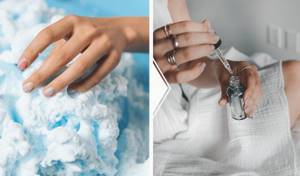
Treatments with olive, castor and burdock oils are especially useful. Plant-based essential oils are effective in strengthening nails. For example, eucalyptus helps maintain the water balance of the nail plate. Rosemary oil relieves inflammation and promotes cuticle healing. By the way, rosemary is known for other beneficial properties.
For compresses, oils are applied to a cotton pad. It needs to be wrapped around the nail. You need to keep this compress for at least 20 minutes, but it is better to do the procedure at night. To do this, you need to wear cosmetic gloves. To remove residual oil, any hand cream will do. The procedure must be repeated at least twice a week.
If your nails are very peeling and you don’t have time for compresses, you can simply rub the oil into the nail plate. This should be done with light massage movements. This procedure can be carried out right at work, without leaving the computer, several times a day.
Another way to strengthen nails is to rub them with oil mixtures. For example, you can take 3 tablespoons of castor, olive and sunflower. If desired and possible, you can supplement this “cocktail” with vitamins A and E from ampoules purchased at the pharmacy. For a volume of 9 tablespoons of oil you need 5 drops of each vitamin.
Why do my nails peel off after gel polish?
In fact, gel polish cannot cause nail splitting. The main reason is the incorrect action of the master, that is, incorrect removal of the material.
Why do nails peel after gel polish:
- This is usually encountered by girls who apply gel polish at home on their own. This means that in most cases, in the absence of a router, gel polish is removed using acetone-containing liquids.
- They destroy the nail plate, fluff up the scales, making the nails flaky. Therefore, the easiest option to avoid peeling nails under gel polish is to use a device rather than a remover.
- For these purposes, a router is usually used and after covering the nails with gel polish, if necessary, remove it, the material is ground down to the base. That is, the base itself, the base remains on the plate and is not removed. A thin layer of it remains as a substrate.
- If you do everything correctly and do not remove the material down to the natural nail, along with its top layer, then the plates will not peel off. If they peel, regardless of whether there is gel polish on them or not, then such a nail plate is considered to be problematic.
- Subsequently, when applying gel polish, difficulties will arise: chips, detachments, and peeling nails under the thickness of the artificial material.
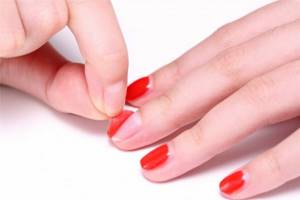
Removable with film
Nails peeling off under gel polish - what to do?
The ideal option is to use a more rigid material, which serves as a reinforcing layer and strengthens the plate, preventing it from bending and moving. Accordingly, the ideal option would be to strengthen nails with gel, polygel, or acrylic.
Nails peel under gel polish, what to do:
- In this case, the material is applied to the surface of the natural nail, after which a coating is applied. However, even if everything is done correctly, under hard and tough material, soft natural nails can begin to flake and flake off from the artificial material.
- There is no need to be upset, there is a solution. In this case, after applying an artificial coating to the nails, that is, a hard material such as gel, polygel or acrylic, the master uses a cutter to cut out the natural plate, leaving only the artificial material at the end.
- It is not always necessary to cover your nails with artificial material, strengthening them with acrylic or gel. Now there is a lot of information that gel polish harms natural nails, making them thin and vulnerable, peeling.
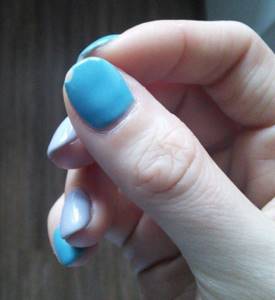
Detachments from the end
How to apply gel polish on peeling nails?
On top of the layer of such a base is applied a layer of a more rigid one, that is, one that does not bend. In this case, the material in the middle, that is, the movable base, will serve as a kind of layer between the natural nail and the artificial gel polish coating. This can inhibit the appearance of detachments and peeling nails.
How to apply gel polish on peeling nails:
- Be sure to apply dehydrator and primer to your nails several times during the preparation process. If your nails are very capricious, use an acidic primer. Despite the harm, it still has a better effect on the nail plate and promotes better adhesion of the artificial material to the natural nail.
- Be sure to use a bonder that glues the artificial nail to the natural one. It acts on the principle of adhesive tape and has a sticky base, both on the side of the nail and the artificial material.
- After a manicure, if it’s not your first and the plate still peels off from the gel polish, you should cut out the free edge.
- If all the tips did not help, the nails continue to peel off from the artificial material and peel off underneath it, the only possible option is to cover it with hard gel, polygel, or acrylic and cut out the natural nail.
- Please note that this is best done using a ceramic needle or spruce cutter. It is better not to use carbide cutters for cutting out natural nails, as they heat up during operation, which can cause additional detachments. The plate heats up, and so does the material, and it peels off.

Crack in the center
Incorporate milk into your home nail care routine
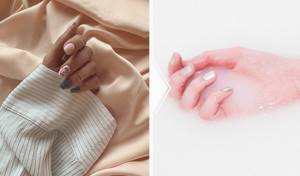
Please note: the fattier the milk, the better. It needs to be heated to a comfortable temperature, hold your fingers in it for 20–30 minutes and wash your hands thoroughly. You can add honey and a few drops of lemon juice to the milk bath. A positive result appears faster if you do the procedure daily.
Base for peeling nails: list
We advise you to change the base and use not one, but two. At the initial stage, a soft movable base is applied, which bends along with the nail.
Base for peeling nails, list:
- UNO. The rubber base is thick and takes a long time to level out.
- Nano Professional NANLAC Gum . Very thick, takes a long time to level out.
- RIO Profi Rubber. Very thick, does not self-level well.
- Artex. The consistency is medium, it bakes a little at high power.
Varnishes for peeling nails: reviews
If you completely drink the nail and properly prepare the nail plate, the problem will go away. Of course, instead of covering natural nails, you get a kind of extension, but if you want a beautiful manicure, then this option will be an excellent solution. This is a good way to get beautiful, long nails with a very thin, flaky and flexible nail plate.
Varnishes for peeling nails, reviews:
Christina, 41 years old. I often used different bases, but did not always get the desired effect. Sometimes, the base peeled off, the vinyl material or the plate was prepared incorrectly. However, after several such manipulations, I realized that the gel polish was chipping due to the very thin nail plate. Now I cover my nails with gel, and only then I apply gel polish. Unfortunately, the gel nails didn’t hold up well until I started cutting out the free edge.
Elena, 25 years old. I don't know how to do my own coating, so I go to a salon. I found myself a good master not so long ago. Unfortunately, before this, the gel polish peeled off, came off in pieces, and the nails peeled off under the layer of material. I changed the technician, and the situation improved. Now the master uses Uno base for problem nails. Unfortunately, the cost of a manicure with such a base is not the most affordable, but it lasts for 3 weeks.
Svetlana, 30 years old. I am a manicurist, I have been doing nails for 7 years. There are also clients who don’t wear gel polish well. Therefore, after the first visit, if chips, detachments are visible, or the coating comes off like a film, I advise you to cover it with acry-gel. I also have Fast-Gel from Cosmoprofi for particularly problematic nails. With these materials nothing flakes off. However, not everyone agrees, since it is much more expensive than regular base leveling.
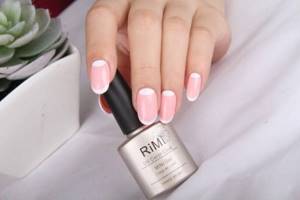
Initially, the master, when unfamiliar with the new nail plate, offers the simplest and most inexpensive option, that is, strengthening the nails with a base. When detachments appear, a rigid base or solid material is selected.
Pros and cons of shellac
Of the minuses:
- Shellac is only suitable for strong and healthy nails.
- The maximum time without chips and detachments is 14 days. More often 7 – 10 days.
- The material will not adhere to thin and weakened nails.
- Shellac can only be removed by soaking. This dries out the nail plate.
- Cannot be used to repair a cracked nail
- A shellac base will not give your nails an ideal shape.
- Shellac is often counterfeited, so there is a risk of allergies or chemical burns.
Pros:
- Chic color palette
- Quick to apply
In 2010, when CND released Shellac, it took the nail industry by storm. After regular polishes that stayed on nails for 2-3 days, Shellac could be compared to man’s first flight into space, or the release of the first iPhone. I covered my nails with it three or four times. For that money, I paid twice as much as a regular coating, but after a week it was embarrassing to walk around with such nails. I was not happy with the coating. Now my opinion about the material has not changed. Shellac itself has also remained the same since 2010, but additional product lines are released every year.
In my opinion, shellac has more disadvantages than advantages. That's why I don't use it at work. What do you think?
For dessert, a video about a machine that paints your nails itself.
So soon a manicurist will no longer be needed
